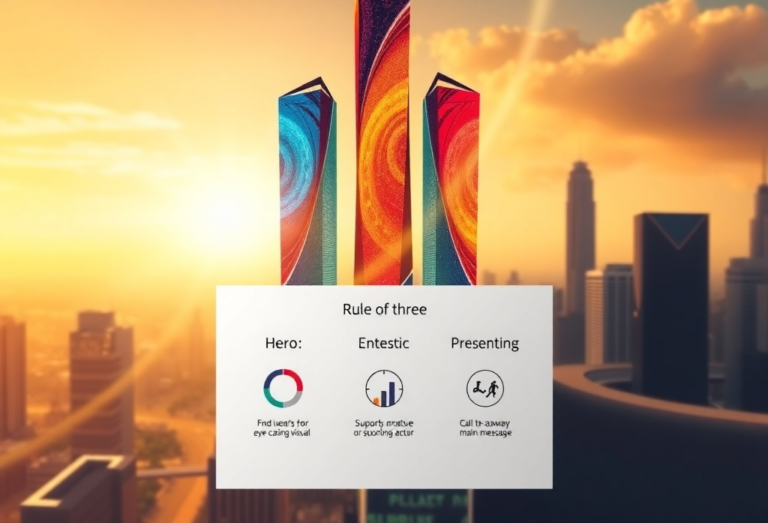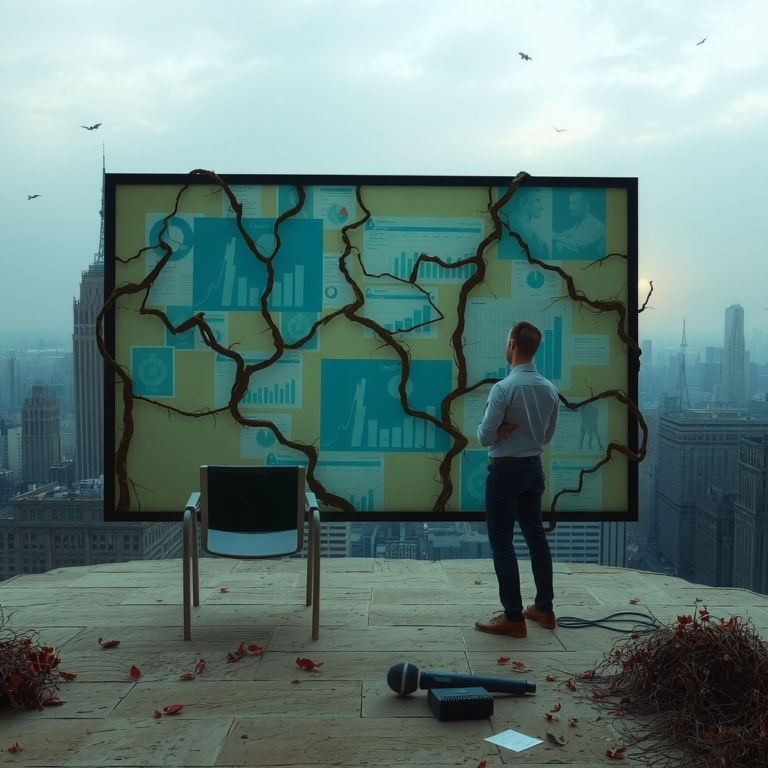Ever watched someone’s eyes during a presentation? It’s a fascinating study in human attention. When a new slide appears, their gaze doesn’t move methodically from top to bottom like reading a book. Instead, it darts around in a seemingly random pattern before settling on something—hopefully the thing you actually want them to notice.
I say “hopefully” because for most presentations, this eye movement is more accident than design. The audience’s attention lands wherever the slide happens to direct it, which is rarely where the presenter intended.
This isn’t just an aesthetic issue—it’s a fundamental communication problem. When your audience’s eyes are drawn to the decorative chart border instead of the concerning trend line, or to the generic stock photo instead of the key statistic beside it, you’re not just missing an opportunity to communicate effectively—you’re actively undermining your own message.
After three decades of designing presentations and tracking what audiences actually look at versus what presenters want them to notice, I’ve learned that visual hierarchy isn’t just a design principle—it’s the invisible architecture that determines whether your ideas sink or soar.
What Exactly Is Visual Hierarchy?
Visual hierarchy is the deliberate arrangement of elements on your slide to control the order in which your audience processes information and the relative importance they assign to each element.
Think of it as the visual equivalent of emphasis in speech. When you talk, you naturally emphasize certain words by changing your volume, pace, or tone. Visual hierarchy does the same thing graphically—it tells your audience, “Pay attention to THIS, then THIS, and consider THIS more important than THAT.”
When done well, your audience processes information in exactly the sequence and priority you intended, without even realizing they’re being guided.
Why Your Brain Demands Hierarchy
Before diving into techniques, let’s understand why visual hierarchy is neurologically essential, not just aesthetically pleasing:
The Cognitive Overload Protection
The human brain can only process a limited amount of visual information at once (about 3-4 chunks). Without clear hierarchy, your audience’s cognitive resources are wasted trying to determine what’s important rather than understanding what’s important.
The Orientation Necessity
When presented with new visual information, your brain first seeks to orient itself by establishing “where am I and what matters here?” Without clear signals, this orientation phase creates anxiety and disconnection.
The Attention Economics
Attention is your audience’s most valuable and limited resource. Every element that competes for attention without contributing to your message is literally stealing focus from what matters.
The Seven Laws of Visual Hierarchy That Control the Eye
Through years of testing and refinement, I’ve identified seven fundamental principles that determine where the eye goes on a slide:
1. Size Dominates Everything
Larger elements will attract attention before smaller ones, regardless of other factors. This sounds obvious, yet I regularly see presentations where the most important numbers are smaller than decorative elements.
The Law in Action: Make your most important element 2-3 times larger than secondary elements. Don’t be subtle—the size difference should be unmistakable.
2. Contrast Creates Focus
Elements that strongly contrast with their surroundings get noticed first. This applies to color (dark vs. light), shape (angular vs. rounded), and even concept (traditional vs. unexpected).
The Law in Action: Place a dark element on a light background (or vice versa) to immediately draw the eye. Just ensure you’re creating contrast around your key message, not around something irrelevant.
3. Position Sets Priority
Western audiences scan slides in roughly an F-pattern: across the top, down the left side, and then across the middle. Elements in the upper left receive disproportionate attention.
The Law in Action: Place your most critical information in the top third of the slide, ideally starting at the left. Save the bottom right for supporting details or reference information.
4. Color Signals Importance
Color attracts attention, especially when it breaks from an established pattern. Our visual system evolved to notice things that are different because they might represent opportunity or threat.
The Law in Action: Establish a restrained color scheme, then use a contrasting accent color exclusively for the elements you want to emphasize. Don’t create a rainbow where nothing stands out.
5. Space Creates Emphasis
Elements surrounded by white space receive more attention than those crammed together. This isn’t about aesthetics—it’s about creating a visual “spotlight” that isolates and emphasizes key information.
The Law in Action: Increase the margin around your most important element by at least 50% compared to other elements. This isolation instantly elevates its perceived importance.
6. Direction Creates Movement
Lines, edges, and particularly arrows create directional forces that literally pull the eye through your slide in specific patterns. This flow can either reinforce your intended sequence or fight against it.
The Law in Action: Use subtle directional cues to create a visual “path” from your first important element to your second. This could be an actual arrow, the gaze direction of a person in a photo, or even the implied line created by arranging elements.
7. Typographic Weight Establishes Order
Variations in font weight, style, and size create instant hierarchy. Bold, unique, or large typography will always attract attention before standard text.
The Law in Action: Establish a consistent typographic system with clear distinctions between titles, subtitles, body text, and emphasis text. Then stick to it religiously throughout your presentation.
The Deadly Sins of Visual Hierarchy
Now that we understand the principles, let’s examine the most common mistakes that destroy effective visual hierarchy:
1. The Equal Emphasis Trap
Making everything bold, colorful, or large doesn’t emphasize everything—it emphasizes nothing. When everything shouts, your audience hears only noise.
The Fix: For every slide, identify the ONE thing your audience must remember. Make that element visually dominant, then deliberately reduce the visual weight of everything else.
2. The Decorative Distraction
Using visually dominant decorative elements (borders, backgrounds, generic icons) that compete with actual content for attention.
The Fix: Apply the “squint test”—blur your eyes while looking at your slide. The element that stands out should be your key message, not a decorative flourish.
3. The Template Tyranny
Blindly following templates that place structural elements (headers, footers, logos) in visually dominant positions at the expense of your actual content.
The Fix: Adapt templates to serve your content, not vice versa. If your company logo is the most noticeable element on every slide, your hierarchy is serving your brand guidelines, not your message.
4. The Relationship Confusion
Creating visual relationships between unrelated elements (or worse, separating related elements) through proximity, color, or style.
The Fix: Elements that relate conceptually should relate visually. Use consistent visual treatment to group related information and distinct treatment to separate unrelated information.
5. The Action Burial
Hiding your call to action or key takeaway in a visually subordinate position or treatment, leaving audiences unclear about what they should do with the information presented.
The Fix: Give your call to action or key conclusion the prime visual real estate—make it impossible to miss through size, position, contrast, and isolation.
Creating Deliberate Visual Pathways
Rather than leaving eye movement to chance, strategic slide design creates intentional visual pathways that guide audience attention in a specific sequence:
The Z-Pattern Pathway
For slides with relatively equal elements that should be processed in a specific sequence, arrange information in a Z-pattern (top left → top right → bottom left → bottom right), using subtle directional cues at each transition point.
This works particularly well for process slides or step-by-step explanations.
The Spotlight Pathway
For slides with one dominant element and supporting information, create a clear visual “spotlight” on the main element through size, contrast, and isolation, with visually subordinate elements positioned to be discovered after the main point.
This works well for key statistics, main conclusions, or primary insights.
The Revelation Pathway
For complex information that would overwhelm if presented all at once, create a sequential reveal pattern that controls exactly what the audience sees at each moment, using animation thoughtfully (not decoratively).
This works particularly well for complex data or multifaceted arguments.
Applying Visual Hierarchy to Common Slide Types
Different types of slides require different hierarchy approaches:
Data Slides
Primary focus: The insight, not the data itself Hierarchy strategy: Use color, size, and annotation to make the meaningful trend or comparison unmissable while visually subordinating contextual data Common mistake: Giving equal visual weight to all data points, forcing the audience to hunt for significance
Concept Slides
Primary focus: The relationship between elements Hierarchy strategy: Use position and connecting elements to create a clear visual flow that matches the conceptual relationship Common mistake: Creating visually competing elements that obscure the relationship you’re trying to explain
Text-Heavy Slides
Primary focus: The key takeaway or most important statement Hierarchy strategy: Create dramatic contrast between your key point and supporting text through size, weight, color, and position Common mistake: Uniform text treatment that forces the audience to read everything to find what matters
Photo-Based Slides
Primary focus: The relationship between the image and your message Hierarchy strategy: Ensure the focal point of the image leads to your key text or data, not away from it Common mistake: Choosing images based on aesthetic appeal rather than how they direct attention
The Five-Minute Hierarchy Fix
If you’re facing a presentation deadline and need a quick hierarchical upgrade, apply this five-minute process to each slide:
1. The Message Test
Write down the ONE thing your audience must remember from this slide. Just one.
2. The Dominant Element Check
Identify what currently draws your eye first on the slide. If it’s not your “one thing,” something needs to change.
3. The Size Adjustment
Make your key message at least twice as large as any other element on the slide.
4. The Contrast Enhancement
Apply a contrasting color ONLY to your key message or the data that supports it.
5. The Clutter Elimination
Remove or visually subdue any element that doesn’t directly support your “one thing.”
This rapid process won’t create design perfection, but it will dramatically improve your slide’s communication effectiveness.
Conclusion: Invisible Influence Through Visual Hierarchy
Masterful visual hierarchy feels invisible to your audience—they simply absorb your information in exactly the order and priority you intended, focusing effortlessly on what matters most.
This invisibility makes hierarchy easy to underestimate or overlook in the presentation development process. Yet few design elements have more impact on whether your message is understood, remembered, and acted upon.
In a world where attention is increasingly fragmented and presentations compete with smartphones, email notifications, and mental to-do lists, strong visual hierarchy isn’t just a design nicety—it’s the difference between a message that lands and one that’s lost in the visual noise.
The next time you create a slide, remember: your audience’s eyes will go somewhere first. Make sure it’s where you want them to go.
Paul Mansfield is a PowerPoint designer with over 30 years of experience transforming corporate presentations from boring to brilliant. He believes that visual hierarchy is the secret weapon that separates presentations that merely inform from those that genuinely influence. Learn more at paulmansfield.net




